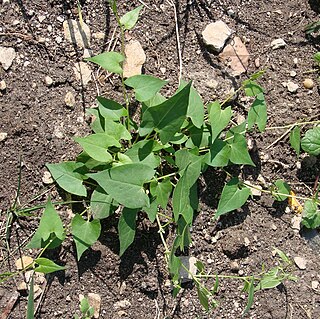
The Polygonaceae are a family of flowering plants known informally as the knotweed family or smartweed—buckwheat family in the United States. The name is based on the genus Polygonum, and was first used by Antoine Laurent de Jussieu in 1789 in his book, Genera Plantarum. The name may refer to the many swollen nodes the stems of some species have, being derived from Greek, poly meaning 'many' and gony meaning 'knee' or 'joint'. Alternatively, it may have a different derivation, meaning 'many seeds'.

Buckwheat, or common buckwheat, is a flowering plant in the knotweed family Polygonaceae cultivated for its grain-like seeds and as a cover crop. The name "buckwheat" is used for several other species, such as Fagopyrum tataricum, a domesticated food plant raised in Asia.

The genus Fagopyrum is in the flowering plant family Polygonaceae. It includes some important food plants, such as F. esculentum (buckwheat) and F. tataricum. The genus is native to the Indian subcontinent, much of Indochina, and central and southeastern China. Species have been widely introduced elsewhere, throughout the Holarctic and parts of Africa and South America.

Polygonum is a genus of about 130 species of flowering plant in the buckwheat and knotweed family Polygonaceae. Common names include knotweed and knotgrass. In the Middle English glossary of herbs Alphita, it was known as ars-smerte. There have been various opinions about how broadly the genus should be defined. For example, buckwheat has sometimes been included in the genus as Polygonum fagopyrum. Former genera such as Polygonella have been subsumed into Polygonum; other genera have been split off.

Fallopia convolvulus, the black-bindweed or wild buckwheat, is a fast-growing annual flowering plant in the family Polygonaceae native throughout Europe, Asia and northern Africa.

Fagopyrum tataricum, also known as Tartary buckwheat, green buckwheat, ku qiao, Tatar buckwheat, or bitter buckwheat, is a domesticated food plant in the genus Fagopyrum in the family Polygonaceae. With another species in the same genus, common buckwheat, it is often counted as a cereal, but the buckwheats are not closely related to true cereals.

Rutin, also called rutoside, quercetin-3-O-rutinoside and sophorin, is the glycoside combining the flavonol quercetin and the disaccharide rutinose. It is a flavonoid found in a wide variety of plants, including citrus.

Quercitrin is a glycoside formed from the flavonoid quercetin and the deoxy sugar rhamnose.

2-Nonenal is an unsaturated aldehyde. The colorless liquid is an important aroma component of aged beer and buckwheat.
Decanal is an organic compound classified as an aldehyde with the chemical formula C10H20O.

Furaneol, or strawberry furanone, is an organic compound used in the flavor and perfume industry. It is formally a derivative of furan. It is a white or colorless solid that is soluble in water and organic solvents.
(E,E)-2,4-Decadienal is an aromatic substance found in butter, cooked beef, fish, potato chips, roasted peanut, buckwheat and wheat bread crumb. In an isolated state, it smells of deep fat flavor, characteristic of chicken aroma (at 10ppm). At lower concentration, it has the odor of citrus, orange or grapefruit. It might be carcinogenic. It has been used as aroma in the EU, but use restrictions apply until the required data have been submitted.

Phenylacetaldehyde is an organic compound used in the synthesis of fragrances and polymers. Phenylacetaldehyde is an aldehyde that consists of acetaldehyde bearing a phenyl substituent; the parent member of the phenylacetaldehyde class of compounds. It has a role as a human metabolite, a Saccharomyces cerevisiae metabolite, an Escherichia coli metabolite and a mouse metabolite. It is an alpha-CH2-containing aldehyde and a member of phenylacetaldehydes.

Geitonoplesium is a monotypic genus in the family Asphodelaceae, containing the sole species Geitonoplesium cymosum, commonly known as scrambling lily. The species is a perennial evergreen scrambling vine found in rainforests, sclerophyll forests and woodlands of eastern Australia, and parts of Malesia and Melanesia.

2-Methoxy-4-vinylphenol is an aromatic substance used as a flavoring agent. It is one of the compounds responsible for the natural aroma of buckwheat.

Epicatechin gallate (ECG) is a flavan-3-ol, a type of flavonoid, present in green tea. It is also reported in buckwheat and in grape.

Fagopyrin is a term used for several closely related naturally occurring substances in the buckwheat plant. Their chemical structure contains a naphthodianthrone skeleton similar to that of hypericin.
Buckwheat is a plant cultivated for its grain-like seeds; it is also used as a cover crop.

Buckwheat whisky is a type of distilled alcoholic beverage made entirely or principally from buckwheat. It is produced in the Brittany region of France and in the United States. Soba shōchū is a similar but weaker beverage produced in Japan. Liquor produced from the distillation of buckwheat honey is also sometimes sold as buckwheat whisky or whiskey, though technically this is a type of distilled mead.
















